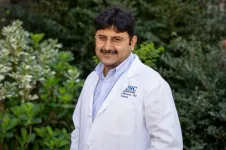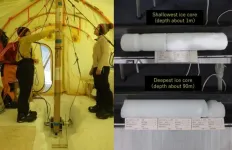(Press-News.org) MUSC Hollings Cancer Center researchers added to the understanding of the protective immune response against the SARS-CoV-2 virus in a study published in April in iScience. The team found that approximately 3% of the population is asymptomatic, which means that their bodies can get rid of the virus without developing signs of illness.
The researchers screened more than 60,000 blood samples from symptomless individuals in the Southeastern U.S., including Georgia, South Carolina and North Carolina, for the IgG antibody to the viral spike protein.
What began as a highly collaborative statewide effort to detect SARS-CoV-2 accurately, when tests were lacking, has led to discoveries. Last year, Shikhar Mehrotra, Ph.D., professor, and scientific director of the FACT-accredited Clean Cell Therapy Unit at MUSC, led the task of developing a method to detect COVID-19 infections rapidly in patients.
The research team developed an orthogonal ELISA-based serological assay, which allows for large-scale antibody testing. While commercial antibody tests are now more readily available, the work has excellent strength in findings because of the exceptionally large sample size, said Mehrotra. Studies such as this shed light on the current unknowns, such as the longevity of the antibodies, their ability to protect from repeat infections and the protective concentration (titer) of neutralizing antibodies.
"As cancer researchers who focus on understanding the role of the immune system in cancer, we are well-positioned to tackle the difficult immunity questions raised by COVID-19. This work was a concerted effort with the highly skilled scientists in the Clean Cell Facility who processed this large sample population," said Mehrotra.
Disease-specific antibody research is necessary to understand protective immunity and understand more fully the prevalence of infection and immune responses to both the virus and vaccines. The team found that high levels of anti-S IgG, the antibody that detects the spike protein, and anti-RBD IgG, the antibody that detects the receptor-binding domain of the spike protein, strongly correlated with neutralizing activity, meaning they defend the person from the virus. Antibodies from 94 hospitalized COVID-19 patients were also assessed: the data showed that compared to asymptomatic individuals with high anti-S IgG, sick patients had decreased antibody responses and reduced neutralizing activity.
The data showed that younger (30 years old and younger) versus older individuals had the highest antibody responses. Also, the findings matched other reports indicating that COVID-19 is disproportionately high in African Americans in Southeastern states.
In the future, this tool can be used to monitor antibody levels upon vaccination or as a screening tool for therapeutic convalescent plasma. Since analyzing neutralizing antibodies in all patients and asymptomatic individuals is challenging, the results indicate that IgG anti-S or RBD can act as a surrogate in determining neutralizing activity in individuals tested for SARS-CoV-2 infection or vaccine response.
More studies are needed to understand the differences between neutralizing antibodies in asymptomatic and hospitalized individuals. Follow-up studies can be done with this extensive data set; for example, the biomarkers between asymptomatic and symptomatic individuals can be compared.
The increase in cross-disciplinary research reveals how novel strategies can accelerate research across medical subdisciplines. The development of mRNA-based COVID vaccines is anticipated to boost cancer research developments. For two decades, scientists have been trying to use RNA as a therapeutic but with little success, since RNA naturally degrades quickly. Now, with the COVID vaccines, it is apparent that stabilizing techniques are feasible and can be translated to other applications, such as cancer vaccines targeting markers on cancer cells or epitopes.
Identifying disease prevalence as a whole helps public health leaders to target interventions and prioritize resources. "Research across the biomedical research spectrum over the last year has demonstrated how public health can be accelerated by collaboration from all sectors, including academic, pharmaceutical and regulatory agencies," said Mehrotra.
INFORMATION:
Funding support from the MUSC President's Office for COVID-19 research, South Carolina Clinical & Translational Research Award and in part by NIH R01CA138930 and R01CA250458.
About MUSC
Founded in 1824 in Charleston, MUSC is the oldest medical school in the South as well as the state's only integrated academic health sciences center with a unique charge to serve the state through education, research and patient care. Each year, MUSC educates and trains more than 3,000 students and nearly 800 residents in six colleges: Dental Medicine, Graduate Studies, Health Professions, Medicine, Nursing and Pharmacy. The state's leader in obtaining biomedical research funds, in fiscal year 2019, MUSC set a new high, bringing in more than $284 million. For information on academic programs, visit musc.edu.
As the clinical health system of the Medical University of South Carolina, MUSC Health is dedicated to delivering the highest quality patient care available while training generations of competent, compassionate health care providers to serve the people of South Carolina and beyond. Comprising some 1,600 beds, more than 100 outreach sites, the MUSC College of Medicine, the physicians' practice plan and nearly 275 telehealth locations, MUSC Health owns and operates eight hospitals situated in Charleston, Chester, Florence, Lancaster and Marion counties. In 2020, for the sixth consecutive year, U.S. News & World Report named MUSC Health the No. 1 hospital in South Carolina. To learn more about clinical patient services, visit muschealth.org.
MUSC and its affiliates have collective annual budgets of $3.2 billion. The more than 17,000 MUSC team members include world-class faculty, physicians, specialty providers and scientists who deliver groundbreaking education, research, technology and patient care
About MUSC Hollings Cancer Center
MUSC Hollings Cancer Center is a National Cancer Institute-designated cancer center and the largest academic-based cancer research program in South Carolina. The cancer center comprises more than 100 faculty cancer scientists and 20 academic departments. It has an annual research funding portfolio of more than $44 million and a dedication to reducing the cancer burden in South Carolina. Hollings offers state-of-the-art diagnostic capabilities, therapies and surgical techniques within multidisciplinary clinics that include surgeons, medical oncologists, radiation therapists, radiologists, pathologists, psychologists and other specialists equipped for the full range of cancer care, including more than 200 clinical trials. For more information, visit hollingscancercenter.musc.edu.
Recently published research from the University of Arizona Health Sciences shows that advanced-stage kidney cancer is more common in Hispanic Americans and Native Americans than in non-Hispanic whites, and that both Hispanic Americans and Native Americans in Arizona have an increased risk of mortality from the disease.
"We knew from our past research that Hispanic Americans and Native Americans have a heavier burden of kidney cancer than non-Hispanic whites," said Ken Batai, PhD, a Cancer Prevention and Control Program research member at the UArizona Cancer Center and research assistant professor of urology in the College of Medicine - Tucson. "But we also know that around 90% of the Hispanic population in Arizona is Mexican American - either U.S.-born or Mexican-born ...
The air in the United States and Western Europe is much cleaner than even a decade ago. Low-sulfur gasoline standards and regulations on power plants have successfully cut sulfate concentrations in the air, reducing the fine particulate matter that harms human health and cleaning up the environmental hazard of acid rain.
Despite these successes, sulfate levels in the atmosphere have declined more slowly than sulfur dioxide emissions, especially in wintertime. This unexpected phenomenon suggests sulfur dioxide emission reductions are less efficient than expected for cutting sulfate aerosols. A new study led by Tokyo Institute of Technology (Tokyo Tech), Hokkaido University and the University ...
The ability of antibodies to recognize specific cancer cells is used in oncology to specifically target those cells with small active agents. Research published in the journal Angewandte Chemie shows that scientists have now built a transport system that delivers even large protein-based drugs into cancer cells. This study demonstrates how proteins can arrive at their target intact, protected from destructive proteases by polymer brushes.
Developing anticancer treatments involves two recurring problems for researchers. An active agent needs to be able to kill the body's cells at the root of the cancer, and it should be active in target cancer cells rather than in healthy cells. Many medical researchers ...
When you save an image to your smartphone, those data are written onto tiny transistors that are electrically switched on or off in a pattern of "bits" to represent and encode that image. Most transistors today are made from silicon, an element that scientists have managed to switch at ever-smaller scales, enabling billions of bits, and therefore large libraries of images and other files, to be packed onto a single memory chip.
But growing demand for data, and the means to store them, is driving scientists to search beyond silicon for materials that can push memory devices to higher densities, ...
For millennia, humans in the high latitudes have been enthralled by auroras--the northern and southern lights. Yet even after all that time, it appears the ethereal, dancing ribbons of light above Earth still hold some secrets.
In a new study, physicists led by the University of Iowa report a new feature to Earth's atmospheric light show. Examining video taken nearly two decades ago, the researchers describe multiple instances where a section of the diffuse aurora--the faint, background-like glow accompanying the more vivid light commonly associated with auroras--goes dark, as if scrubbed by a giant blotter. Then, after a short period of time, the blacked-out section suddenly reappears.
The researchers say the behavior, which they call "diffuse ...
New research published in Experimental Physiology highlight the possible long term health impacts of COVID-19 on young, relatively healthy adults who were not hospitalized and who only had minor symptoms due to the virus.
Increased stiffness of arteries in particular was found in young adults, which may impact heart health, and can also be important for other populations who may have had severe cases of the virus. This means that young, healthy adults with mild COVID-19 symptoms may increase their risk of cardiovascular complications which may continue for some time after COVID-19 infection.
While SARS-CoV-2, the virus known ...
Just as people keep their houses clean and clutter under control, a crew of cells in the body is in charge of clearing the waste the body generates, including dying cells. The housekeeping cells remove unwanted material by a process called phagocytosis, which literally means 'eating cells.' The housekeepers engulf and ingest the dying cells and break them down to effectively eliminate them.
"Phagocytosis is very important for the body's health," said Dr. Zheng Zhou, whose lab at Baylor College of Medicine has been studying phagocytosis for many years and provided key new insights into this essential process. "When this cell-eat-cell process fails, the dying cells will lose their integrity, break down and release their content into the surrounding tissues. Dumping the ...
St. Jude Children's Research Hospital scientists have developed an integrated, high-throughput system to better understand and possibly manipulate gene expression for treatment of disorders such as sickle cell disease and beta thalassemia. The research appears today in the journal Nature Genetics.
Researchers used the system to identify dozens of DNA regulatory elements that act together to orchestrate the switch from fetal to adult hemoglobin expression. The method can also be used to study other diseases that involve gene regulation.
Regulatory elements, also called genetic switches, are scattered throughout non-coding regions of DNA. ...
Retinoblastoma starts in the retina, the thin membrane at the back of the eye. Most patients are infants or toddlers when their cancer is found. Without treatment, the cancer spreads. Thanks to chemotherapy, surgery and other treatments, 96% of patients survive.
St. Jude researchers studied how survivors fared years later at home and at school. A previous St. Jude study of 98 retinoblastoma survivors found that their early learning and life skills declined from diagnosis to age 5.
Researchers tested 78 of the same survivors five years later. The results were more upbeat. By age 10, almost all the children functioned within the normal range ...
Asthma attacks account for almost 50 percent of the cost of asthma care which totals $80 billion each year in the United States. Asthma is more severe in Black and Hispanic/Latinx patients, with double the rates of attacks and hospitalizations as the general population.
When the COVID-19 pandemic swept over the United States, a series of reports suggested that fewer people were coming to emergency departments for all sorts of medical problems, including asthma attacks and even heart attacks. In the case of asthma, it was not clear if the drop was due to people avoiding emergency services or due to better asthma control. A new analysis from investigators at Brigham and Women's Hospital shines new light on this question. In a report of ...



